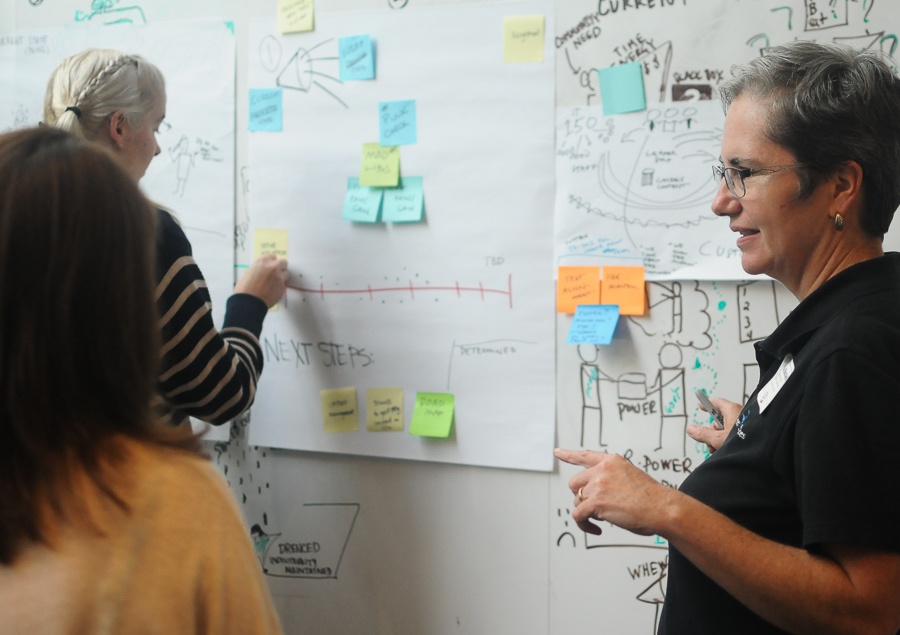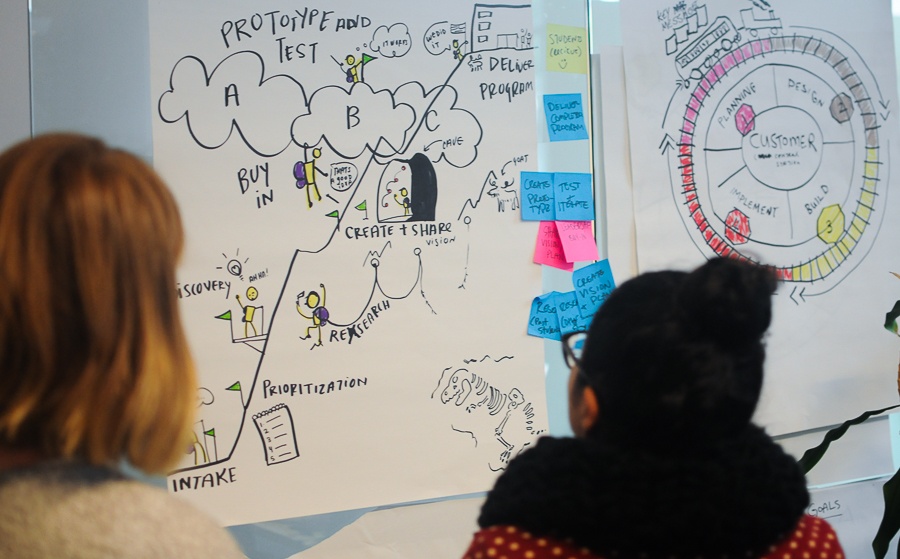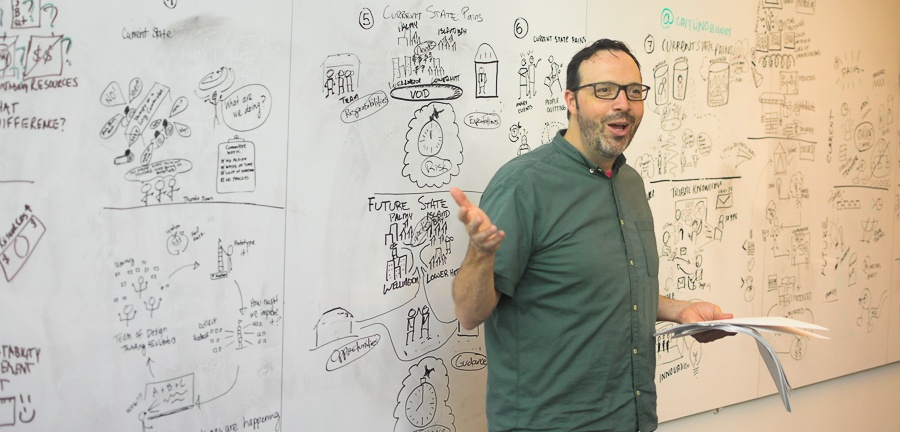Whether you are an experienced designer looking for fresh inspiration or a left-brain devotee who proclaims, “I don’t draw!” XPLANE’s Visual Thinking Workshop has something for everyone. As a digital producer and strategic design manager, I land right in the center: half my brain is analytically-oriented (crunching budget numbers and scheduling resources), while the other half is visually-minded (art direction and image composition). XPLANE’s Visual Thinking Workshop provided the perfect balance—using pictures to solve complex problems! And with Tim May, one of XPLANE’s longtime creative directors (@freshbeast on Twitter and Instagram), as our fearless and fun facilitator, it took no time at all to bust through our pre-conceived barriers, armed with Sharpies in hand!
The workshop was a two-day immersive learning experience, and participants could sign up for either one or both of the days.
Day 1: Visual Thinking 101
Day one started at the very beginning by explaining what visual thinking is and why it matters. Tim explained how the brain is wired for processing visual information and that visual thinking “leverages humans’ most powerful capability for understanding: visualization.” Tim then walked through the basic building blocks of visual thinking, from the visual alphabet’s core elements, such as a dot, line, arc, circle, etc. to how these elements combine to become simple objects or nodes, a pair of reading glasses, lightbulb or cat, for example. After demonstrating how to draw quick, informative people, participants were instructed to partner up, strike a pose and try a hand at sketching their own people in action.
Armed with elements and nodes, we progressed to the next step of how to use visualization to tell a story. But first, who is the story for? Who is your audience? What do you want them to do? Tim introduced the Empathy Map to help understand the needs and influences of the audience: what are they thinking, seeing, hearing, saying and feeling? What are the pains vs. gains? This brainstorm exercise is useful in order to design a story or solution that resonates directly with your audience.

Now, with the audience in mind, Tim walked through the next component for exploring, organizing and communicating information: Visual Frameworks, consisting of Systems (the “What”), Processes (the “How) and Comparisons (“the Why”). Lastly, Tim described how a Visual Framework can be filtered through one of three approaches: Schematic (head/logic), Metaphor (heart/emotion) and Literal (hand/reality). Examples where shared with the group and then came our final drawing challenge of the day. Tim played an audio track of a rapid-fire TED talk which we were then instructed to visually capture on a blank poster-sheet bringing together the elements that make up the nodes which form the framework as filtered through an approach that comprises the visual narrative that tells the story (whew!). And you know what? Everyone rocked it! Day 1 closed on a high note, with participants enthusiastic about drawing, empowered with new, practical knowledge, and energized to learn more!
Day 2: Visual Thinking 201
Day two focused on practicing all the parts and pieces we’d learned throughout Day 1. Tim walked through several tools and activities that are helpful to jumpstart visual thinking and align audiences, such as an Altitude Map to determine elevation (i.e. sky-high level executive overview vs. in-the-weeds technical detail). Additionally, Tim introduced Stephanie Gioia, XPLANE’s Director of Consulting, to share examples of visual canvases, worksheets, games and online resources that are handy for brainstorming, innovating and idea generation.

The real value of the day came when we divided into teams of four to navigate through an actual team member’s workplace challenge. Using a real-world scenario, the teams were tasked with developing a plan using the visual thinking techniques, tools, and approaches to navigate towards a solution. As a closing activity, each team shared their particular challenge and sense-making process in driving towards and understanding the solution. Questions, feedback, and helpful suggestions were discussed amongst the group. It was a true testament when at the end of the day people were packing up their posters to take back and share within their own organizations!
Attendees walked away from the visual thinking training with an abundance of helpful resources, activities, and takeaways, along with the knowledge, practice, and confidence to apply their learnings within their own organizations. Tim May was an inspiring host throughout the Workshop, imparting expert knowledge, colorful anecdotes, enthusiastic cheerleading, and his very own dash of @freshbeast style that kept the energy high and interest focused throughout the two days. So whether you’re a newbie or a pro, or somewhere right in the center, XPLANE’s Visual Thinking Workshop provides a valuable and informative hands-on experience for everyone.

Our Guest Author
Visual Thinking Workshop review was written by guest blogger Annie Pomeranz. Annie is a digital producer and strategic design manager in Portland, OR.
